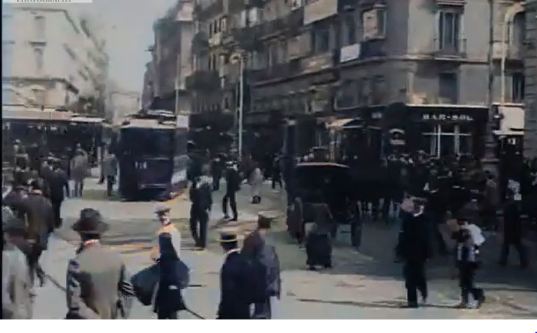The Italian
R: Reginald Barker. B: Thomas H. Ince, C. Gardner Sullivan. D: George Beban, Clara Williams, J. Frank Burke. P: Thomas H. Ince / New York Motion Picture. USA 1915
Print: Library of Congress, Washington D.C.
“It tells the story of an immigrant Venetian named Pietro ‘Beppo’ Donnetti (George Beban). The film follows Beppo after he moves to New York from Italy in the 1910s. Upon arrival, Beppo experiences the precarious state of being an immigrant, encountering thieves, criminal gangs and being robbed by street vendors. This kind of immigrant experience is integral to America’s cultural imagination, and I believe constitutes the archetype for contemporary New York diasporic gangster movies. (…)
The Italian is certainly an important documentation of American Social history, charting a narrative that has since been retold again and again: that of the immigrant and the urban underbelly. But isn’t all of film history subject to the cementing and re-cementing of popular narratives? In the case of The Italian, the film explores a dark subject that was incredibly forward thinking for 1915. D.W. Griffith’s The Birth of a Nation (released the same year) comes to mind, a film with strikingly conservative and disturbingly racist narrative and characterisation to modern eyes.”
James Harrison
realreeljournal
“By portraying immigrants as both pittoresque and ill-fated, American films struck a fine, yet universalist balance between catering to familiar aesthetic responses and encouraging forms of emotional identification. Crucial to these processes was the Irish-Dalmatian figure of George Beban, whose stage and film career recapitulates the relationship between silent American cinema and race. If in the mid-1900s Petrosino was the Italian face of the American justice system, in the mid-1910s Beban became the Italian face of the American cinema.”
Giorgio Bertellini: Italy in Early American Cinema: Race, Landscape, and the Picturesque. Indiana University Press 2010, p. 214
The District Attorney’s Conscience
R: Arthur V. Johnson. D: Arthur V. Johnson, Lottie Briscoe, Howard M. Mitchell, Charles Brandt, Florence Hackett. P: Lubin Manufacturing Company. USA 1913
Print: EYE
Dutch titles
>>> Plot summary in English here
“Before Beban’s feature character performances, other, shorter films had explicitly explored the narrative possibility of humanizing Italians as victims of injustice. They included Out of the Past (Vitagraph, 1910) – ‘A Special Two-Part Feature Drama of Italian American Life’ -; Trials of an Immigrant (Reliance, 1911) about the ‘piteous trials of an Italian woman, wife of a drunken immigrant’; and The District Attorney’s Conscience (Lubin, 1913).”
Giorgio Bertellini: Italy in Early American Cinema: Race, Landscape, and the Picturesque. Indiana University Press 2010, p. 345, fn. 36
>>> L’emigrante (Febo Mari) and The Two Roses (Dir. unknown)

